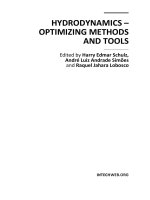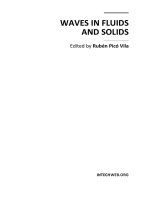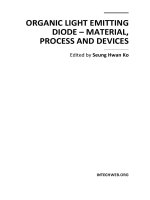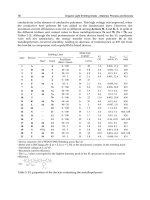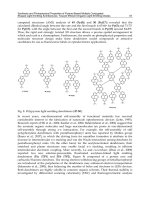Organic Light Emitting Diode Material Process and Devices Part 1 pot
Bạn đang xem bản rút gọn của tài liệu. Xem và tải ngay bản đầy đủ của tài liệu tại đây (1.08 MB, 25 trang )
ORGANIC LIGHT EMITTING
DIODE – MATERIAL,
PROCESS AND DEVICES
Edited by Seung Hwan Ko
Organic Light Emitting Diode – Material, Process and Devices
Edited by Seung Hwan Ko
Published by InTech
Janeza Trdine 9, 51000 Rijeka, Croatia
Copyright © 2011 InTech
All chapters are Open Access articles distributed under the Creative Commons
Non Commercial Share Alike Attribution 3.0 license, which permits to copy,
distribute, transmit, and adapt the work in any medium, so long as the original
work is properly cited. After this work has been published by InTech, authors
have the right to republish it, in whole or part, in any publication of which they
are the author, and to make other personal use of the work. Any republication,
referencing or personal use of the work must explicitly identify the original source.
Statements and opinions expressed in the chapters are these of the individual contributors
and not necessarily those of the editors or publisher. No responsibility is accepted
for the accuracy of information contained in the published articles. The publisher
assumes no responsibility for any damage or injury to persons or property arising out
of the use of any materials, instructions, methods or ideas contained in the book.
Publishing Process Manager Iva Lipovic
Technical Editor Teodora Smiljanic
Cover Designer Jan Hyrat
Image Copyright demarcomedia, 2010. Used under license from Shutterstock.com
First published July, 2011
Printed in Croatia
A free online edition of this book is available at www.intechopen.com
Additional hard copies can be obtained from
Organic Light Emitting Diode – Material, Process and Devices, Edited by Seung Hwan Ko
p. cm.
ISBN 978-953-307-273-9
free online editions of InTech
Books and Journals can be found at
www.intechopen.com
Contents
Preface IX
Part 1 OLED Materials 1
Chapter 1 Synthesis, and Photo- and Electro-Luminescent
Properties of Phosphorescent Iridium- and
Platinum-Containing Polymers 3
Yuji Koga and Kouki Matsubara
Chapter 2 Synthesis and Photophysical Properties of Pyrene-Based
Multiply Conjugated Shaped Light-Emitting Architectures:
Toward Efficient Organic-Light-Emitting Diodes 21
Jian-Yong Hu and Takehiko Yamato
Chapter 3 Organometallic Materials for
Electroluminescent and Photovoltaic Devices 61
Boris Minaev, Xin Li, Zhijun Ning, He Tian and
Hans Ågren
Chapter 4 High Efficiency Red Phosphorescent Organic
Light-Emitting Diodes with Simple Structure 101
Ramchandra Pode and Jang Hyuk Kwon
Chapter 5 Organic Field-Effect Transistors Using
Hetero-Layered Structure with OLED Materials 147
Ken-ichi Nakayama, Yong-Jin Pu, Junji Kido
and Masaaki Yokoyama
Chapter 6 Organic Light Emitting Diodes Based
on Novel Zn and Al Complexes 161
Petia Klimentova Petrova, Reni Lyubomirova Tomova
and Rumiana Toteva Stoycheva-Topalova
Part 2 OLED Processes and Devices 193
Chapter 7 Unconventional, Laser Based OLED Material
Direct Patterning and Transfer Method 195
Seung Hwan Ko and Costas P. Grigoropoulos
VI Contents
Chapter 8 Interlayer Processing for Active Matrix Organic
Light Emitting Diode (OLED) Displays 215
Peter Vicca, Soeren Steudel, Steve Smout, Kris Myny,
Jan Genoe, Gerwin G.H. Gelinck and Paul Heremans
Chapter 9 Transparent Conductive Oxide (TCO) Films for
Organic Light Emissive Devices (OLEDs) 233
Sunyoung Sohn
and Hwa-Min Kim
Chapter 10 Micro-Cavity in Organic Light-Emitting Diode 275
Young-Gu Ju
Chapter 11 Fast-Response Organic Light-Emitting Diode
for Interactive Optical Communication 291
Takeshi Fukuda and Yoshio Taniguchi
Chapter 12 Effect of High Magnetic Field on
Organic Light Emitting Diodes 311
Toshihiro Shimada
Preface
Organic light-emitting diodes (OLED) are playing a major role in information technol-
ogy (IT) by providing the promise of further expanding the use of digital displays
through making display fabrication technology lower in cost and higher in perfor-
mance to replace liquid crystal displays (LCD). Due to various attractive features such
as high contrast, high brightness, large color gamut and thin structure, various sized
OLED displays from small-sized mobile phone display to large-sized TV display have
already begun to be mass-produced.
This book is a collection of state-of-the-art works intended to cover theoretical and ex-
perimental aspects of OLED from material synthesis and characterization (Chapter 1-
6) to actual process development and devices applications (Chapter 7-12). Each chap-
ter features remarkable breakthrough on OLED and provides latest scientific
knowledge and leading-edge technology. They offer research agenda and accelerate
the research, development and distribution of OLED. I expect that this book will be
useful to encourage further experimental and theoretical research in OLED.
In closing, I wish to express my sincere gratitude to the contributing authors of each
chapter, publishing process manager Ms. Iva Lipovic, and the publishing staffs. In par-
ticular, I am deeply grateful to Prof. Costas P. Grigoropoulos (UC Berkeley), Dr. Hee
K. Park (AppliFlex), Dr. Ming-Tsang Lee (Lawrence Berkeley National Laboratory),
Dr. Heng Pan (Applied Materials. Inc) for valuable suggestions. I dedicate this book to
my parents and my wife, Ms. Hyun Jung Kim.
Dr. Seung Hwan Ko
Applied Nano Technology and Science (ANTS) Lab
Korea Advanced Institute of Science and Technology (KAIST),
Daejeon, Korea
Part 1
OLED Materials
1
Synthesis, and Photo- and Electro-Luminescent
Properties of Phosphorescent Iridium- and
Platinum-Containing Polymers
Yuji Koga and Kouki Matsubara
Department of Chemistry, Faculty of Science, Fukuoka University
Japan
1. Introduction
Development of polymer light-emitting diode (PLED) has been attracted considerable
attentions,
1
because polymeric materials could be applied to low-cost production of electro-
luminescent (EL) devices exhibiting efficient luminescence for flat-panel displays. As
polymeric property of the materials enables the solution processes, such as spin-coating,
screen printing, and ink-jet printing (Figure 1), large-area and fine-pixel displays could be
easily developed in comparison with the vapor deposition process. In addition to such easy
preparation, it is of significant that it requires a fewer number of layers in PLED devices,
which enables low driving voltage, even though PLED still has a drawback in lower
luminescence efficiency than that of the organic light-emitting diode (OLED) in general.
to pump
substrate
source
Vapor depositionVapor deposition
nozzle
substrate
nozzle
substrate
spin
Spin-coating Spin-coating
Ink-jet printingInk-jet printing
Fig. 1. Vapor deposition process, spin-coating, and ink-jet printing
In contrast to widely developed fluorescent -conjugated polymers, such as polyfluorenes
and polyphenylene vinylenes (PPVs), as polymeric EL materials (Figure 2),
2
researches for
phosphorescent polymers are still now in progress, because it follows the development of
the phosphorescent metal complexes, which are also in progress. Two types of
Organic Light Emitting Diode – Material, Process and Devices
4
phosphorescent PLED materials are known: (1) host polymers such as poly(vinylcarbazole)
(PVK) and poly(9,9-di-n-octyl-2,7-fluorene) (PFO), into which phosphorescent small
molecules are doped,
1a-f
and (2) polymers having phosphorescent pendant units in the side
chain. In the former polymer, phase separation and crystallization of the small molecules in
the polymer matrix may reduce the luminescence efficiency due to self-quenching
mechanism and prevent uniform emission all over the films. Thus, several studies were
focused on the latter phosphorescent polymer. Lee et al.
3
and Tokito et al.
4
independently
developed non-conjugative copolymers in which monomers having luminescent
cyclometalated iridium pendant units copolymerized (Figure 3), whereas Chen et al.
reported preparation of a conjugative fluorene copolymer from a cyclometalated iridium-
suspended co-monomer (Figure 4).
5
n
PPV
polyfluorene
n
C
n
H
2n+1
C
n
H
2n+1
Fig. 2. Structure of polyfluorene and PPV
N
N N
Ir
xyz
Lee et al.
N
N
CH CH
2
CH CH
2
mn
N
O
N
O
O
Ir N
N
F
F
F
F
CH CH
2
CH CH
2
mn
N
O
O
Ir
N
N
S
S
CH CH
2
CH CH
2
mn
N
O
O
Ir
N
N
Tokito et al.
Fig. 3. Structure of non-conjugated copolymers with luminescent cyclometalated iridium
pendant units
Scheme 1 depicts the general synthetic methodologies for the metallopolymers including the
metal complex side chain. Almost all of the luminescent metallopolymers ((D) in Scheme 1)
have been synthesized via monomers containing metal-complex pendant units (B) (Scheme
1, Method A).
6
However, polymerization of these metal-containing monomers led to the
Synthesis, and Photo- and Electro-Luminescent Properties
of Phosphorescent Iridium- and Platinum-Containing Polymers
5
m n p q
N N
O
Ir
O O
Ir
O
N
N
S
2 2
Chen et al.
Fig. 4. Structure of conjugated fluorene copolymer with luminescent cyclometallated
iridium pendant units
elimination of metal fragments to some extent or failure of polymer weight control.
Alternatively, the polymer (D) can be synthesized by polymerization of a ligand-containing
monomer followed by the reaction of the copolymer ligand (C) with a metal pendant unit
(Scheme 1, Method B). Method B is seemed to be favored against Method A in the preparation
of phosphorescent metallopolymers, because various kinds of ligand monomers can be
easily copolymerized in desirable content with previously developed radical
copolymerization processes in metal-containing polymer chemistry.
7
However, in the early
reports, synthesis of luminescent metallopolymers via Method B was conducted only under
severe conditions, such as Lee, Schulz or Fréchet reported (Scheme 2, 3, 4).
3, 7g
Furthermore, there are few examples that the alpha and/or omega ends of the polmers are
capped eith phosphorescent units for EL materials that can be provided by the final
combination of the ligand unid units in the polymer ends with metal precursors.
PolymerizationPolymerization
Complexation
Complexation
(C) Polymer Ligand
(A) Monomer Ligand
(B) Metal-containing Monomer
(D) Metal-containing Polymer
Method A
Method B
LML
n
LML
n
L L L ML
n
ML
n
ML
n
Scheme 1. Synthetic methodology of metal-containing polymer.
Organic Light Emitting Diode – Material, Process and Devices
6
N
N N
Ir(ppy)
2
xyz
ethylene glycol
170
o
C, 17 h
N
N
xy
++
N
Ir
O
O
OO
O
O
Scheme 2.
N N
C
6
H
13
C
6
H
13
C
6
H
13
C
6
H
13
Ir
N
2
x y
N N
C
6
H
13
C
6
H
13
C
6
H
13
C
6
H
13
Ir
2
x y
OO
N
C
6
H
13
C
6
H
13
x + y
Ir
O
O
OO
O
O
+
m-cresol
reflux, 12 h
m-cresol
reflux, 12 h
N
+
Scheme 3.
O
N
O
Ir
O
N
O
N
N
N
R
R = H, OC
12
H
25
2
xyz
O
N
OO
N
O
N
N
xyz
N N
Ir Ir
Cl
Cl
R R
2 2
+
85
o
C, 5 h
Na
2
CO
3
Scheme 4.
L
L
L
ML
n
ML
n
ML
n
Complexation
Polymer Ligand
Metal-containing Polymer
and/or
Scheme 5.
We previously developed metallopolymers produced from methyl methacrylate (MMA)
and 4-styryldiphenylphosphine copolymers with an iridium precursor. The iridium
polymers performed both photo- and electroluminescence, and showed characteristic
Synthesis, and Photo- and Electro-Luminescent Properties
of Phosphorescent Iridium- and Platinum-Containing Polymers
7
features depending upon the content ratios of the iridium and phosphorus in the
copolymers.
8
However, the devices containing these polymers exhibited rather low
luminescent efficiency, because of its low charge-transporting ability caused by the
nonconductive polyolefin backbone.
Here, we developed several series of iridium or platinum-containing metallopolymers
under mild conditions in Method B, where pyridine was used as a linker module between
the polymer main chain and the luminescent metal unit. Metal-incorporation effects of the
metallopolymers on their luminescent properties were investigated in order to develop
devices with high luminescent efficiency. Two independent types of the metallopolymers
are shown in the following chapters: one is that composed of polyolefin main chain and
metal units in its side chain, and the other is -conjugated polymers, which has the
luminescent metal groups in the chain ends.
2. Preparation of metallopolymers containing polyolefin main chain
In the previous paper, we have reported that luminescent polymers can be easily prepared
by the reaction of the phosphorus ligand copolymers derived from MMA and 4-
styryldiphenylphosphine with the iridium precursor under mild conditions.
8
Unfortunately,
we found that the phosphorus side chain was easily oxidized to form oxide, probably
leading to desorption of metal species from the metallopolymer. Alternatively, to improve
the luminescent polymers, we used 4-vinylpyridine (Vp) as a linker module comonomer. It
has been generally used as a ligand in metallopolymers.
9
In this chapter, we have reported
preparation of a series of new luminescent metallopolymers. First, pyridine-containing
polymers were produced as ligands for metal modules. Then, some amount of iridium
complex precursor, [IrCl(piq)
2
]
2
(3), where piq is 1-phenylisoquinoline, was added to the
ligand polymer.
Scheme 6 depicts the synthetic procedure for the ligand copolymer 1 and the iridium-
containing polymer 5. MMA and Vp were copolymerized in the presence of benzoylperoxide
(BPO) at 80 °C for 10 h to form the random copolymer 1.
10
The number-averaged molecular
weight of 1 was 963000 g/mol, determined by size-exclusion chromatography (SEC) which
was calibrated using polystyrene standards. The
1
H NMR spectroscopy of 1 revealed that the
content of Vp was 23 mol%. These copolymers reacted with [IrCl(piq)
2
]
2
(3) in CH
2
Cl
2
efficiently to form 5, as a red compound. The expected quantity of the vinylpyridine iridium
unit, [IrCl(piq)(Vp)], in metallopolymer 5 was 49 wt%, which was calculated by the feed ratios
of 3 and Vp in 1. The luminescent polymer of platinum analog 6 was also prepared efficiently
by the reaction of 1 with a platinum precursor, [PtCl(piq)]
2
(4), in CH
2
Cl
2
.
In these luminescent polymers, MMA were used as a comonomer in order to reveal the
properties of luminescent modules. However, as noted below, the EL efficiencies of the
devices including such metallopolymers were extremely low, because of the poor
conductivity of MMA copolymer. Therefore, we used N-vinylcarbazole (Vc) as an
alternative comonomer instead of MMA to improve the conductivity and luminescence
property. Poly(N-vinylcarbazole) (PVK) has been known as a host material for OLED
component, performing high conductivity due to closely arranged conjugated sites which
hang from the polyolefin backbone as a pendant group.
11
Scheme 7 depicts the synthetic
procedure for the iridium-containing polymers 7a and 7b from ligand copolymers 2a and
2b, which have different Vp contents, 4.7 and 15 mol%, respectively. The content of Vp was
determined by absorption coefficient ratio for PVK at 345 nm in CHCl
3
(Table 1). The ligand
copolymers 2a and 2b were prepared in the presence of AIBN.
12
The reaction of these
Organic Light Emitting Diode – Material, Process and Devices
8
copolymers with [IrCl(piq)
2
]
2
(3) in CH
2
Cl
2
gave red solutions, similar to the prior
experimental result forming 5 (Table 2). The quantities of the iridium unit,
[IrCl(piq)
2
(Vp)]
y2
, content in the metallopolymers 7a and 7b were 8.4 and 25 wt%, which
were determined by the feed ratios of 3 and Vp in 2a-b.
N
O OMe
+
Me
80℃, 10 h
Me
N
MeO O
xy
1
BPO
reflux, overnight
CH
2
Cl
2
+
[MCl(piq)
n
]
2
Me
N
MeO O
xy
1
N
y
2
N
M
Cl
1
6 : M = Pt, n = 1
4 : M = Pt, n = 1
3 : M = Ir, n = 2
5 : M = Ir, n = 2
n
Scheme 6. Preparation of 1, 5, and 6.
N
+
65℃, 3 h
N
N
x
y
2
AIBN
N
DMF
reflux, 16 h
CH
2
Cl
2
+
N
N
x
y
1
N
y
2
N
Ir
Cl
2
2
7
3
Scheme 7. Synthesis of copolymers 2a-b, and metallopolymers 7a-b.
Synthesis, and Photo- and Electro-Luminescent Properties
of Phosphorescent Iridium- and Platinum-Containing Polymers
9
The MMA-copolymerized metallopolymers 5 and 6 were readily soluble in several organic
solvents, such as CH
2
Cl
2
, and CHCl
3
, whereas the Vc-copolymerized metallopolymers 7 had
poor solubility toward these solvents. Figure 5 shows the
1
H NMR spectra for the
monomeric complex 14, 1, and 5. Broadened signals due to the aromatic protons of 1
appeared from δ 8.5 to 8.2 and from δ 7.1 to 6.6 (Figure 5 (b)), whereas new broad
resonances were observed from δ 10.1 to 6.1 (c), assigned as aromatic protons of the
incorporated iridium unit in 5, which provided the similar set of signals to those
corresponding to 14 (a). The result suggested that the iridium unit in 5 has the same
chemical structure as that of 14. The spectra for 6 were similarly observed. Several
broadened signals assigned as aromatic groups of the iridium unit in 7 were also observed
as shown in Figure 6 (b) and (d). These signals were shifted to the higher field when these
signals were compared with those due to the monomeric analog 14 (Figure 6 (e)), probably
due to the shielding effect of the surrounding aromatic groups of the carbazole side chain.
Ligand
Polymer
Comonomer
Initiator
(mmol)
Yield
(%)
Vp Content
(mol%)
Mn
(×104
g/mol)
PDI
Vp
(mmol)
Other
(mmol)
1
0.93 MMA 9.3 BPO 0.050 100 23 96 2.7
2a
1.0 Vc 20 AIBN 0.10 82 4.7 5.0 2.1
2b
2.0 Vc 20 AIBN 0.10 20 15 3.8 3.5
Table 1. Preparation of Ligand Polymers
Polymer
Complex
Feed Polymer Ligand
(Pyridine Content /
mmol)
Feed Precursor
Complex
(Metal Content / mmol)
Yield
(%)
[IrCl(piq)
2
(Vp)]
y2
Content (wt%)
5 1
0.40
3
0.10 94 49
6 1
0.041
4
0.010 94 41
7a 2a
0.20
3
0.049 95 8.4
7b 2b
0.20
3
0.050 92 25
Table 2. Preparation of Metallopolymers
3. Preparation of metallopolymers containing conjugated polymer main chain
EL materials containing small molecules as doping luminescent compounds and
conjugated polymers, such as PPV and PFO, have been developed as EL materials. Those
performing more efficient luminescence have also been developed directly binding
chromophores in the side chain of the conjugated polymers (Figure 4 and Scheme 3).
5,7f,7g
However, it is unknown that the luminescent iridium or platinum unit directory combines
to the end of the conjugated polymers without breaking the -conjugation, except one
example.
13
The conjugated binding between the host polymer and the guest chromophore
is expected that intramolecular electron transfer occurs easily. Here we developed new
Organic Light Emitting Diode – Material, Process and Devices
10
Fig. 5.
1
H NMR spectra in CD
2
Cl
2
for (a) 14, (b) ligand polymer 1, and (c) metallopolymer 5
in the aromatic region.
Fig. 6.
1
H NMR spectra in CD
2
Cl
2
for (a) 2a, (b) 7a, (c) 2b, (d) 7b and (e) 14 in the aromatic
region.
(a)
(b)
(c)
(d)
(e)
Synthesis, and Photo- and Electro-Luminescent Properties
of Phosphorescent Iridium- and Platinum-Containing Polymers
11
series of conjugated ligand polymers where a pyridyl group was introduced in the both
ends of the polymers. As the previous preparation for the polyolefin metallopolymers, the
luminescent 1-phenylisoquinoline iridium module was efficiently combined to the ligand
polymers after polymerization. The procedures of the ligand polymers 8 and 9 and
metallopolymers 10-13 are shown in Schemes 8 and 9. The conjugated polymer was
prepared by the polycondensation reaction of two comonomers, 9,9-dioctylfluorene
dibromide and bisboronic ester, mediated by a the catalyst system using palladium
acetate, tri(o-methoxyphenyl)phosphine, and sodium carbonate. Subsequent reaction of
the obtained mixture with pyridylboronic acid pinacol ester or pyridylboronic acid
formed the end-capped ligand polymers 8a and 8b in 34 or 53% yield. The content of the
pyridyl group was 2.9 or 2.0 mol%, which was determined by
1
H NMR spectrum. On the
other hand, a comonomer, 4-sec-butylphenyl-N,N-bis(4-bromophenyl)amine, was added
to the polycondensation, resulted in the formation of triarylamine-containing ligand
copolymers 9a and 9b. The yields, averaged moleculer weights, and pyridyl-group
contents are listed in Table 3. The reactions of the ligand polymers 8a and 9a with the
iridium precursor 3 efficiently formed the metallopolymers 10 and 12. The theoretical
ratios of the iridium unit,
[IrCl(piq)
2
(py)] in 10 and 12 were 1.7 and 1.7 wt%.
The platinum analogs 11, 13 were similarly synthesized from 8b, 9b and the platinum
precursor 5. The yields and the content ratios of iridium and platinum are listed in
Table 4.
Toluene / Na
2
CO
3
aq.
Aliquat 336
Pd(OAc)
2
P(o-MeOC
6
H
4
)
3
1) 105℃, 3 h
2) 105℃, 21 h
B B
C
8
H
17
C
8
H
17
O
O
O
O
Br Br
C
8
H
17
C
8
H
17
N BR
++
2)
9 : y / z = 0.9 / 0.1
C
8
H
17
C
8
H
17
N
y
N N
z
x
NBr Br
8 : y / z = 1.0 / 0.0
+
BR =
O
B
O
B
OH
OH
or
Scheme 8. Preparation of the conjugated ligand polymers 8 and 9.
The metallopolymers 12 and 13, in which the 4-sec-butylphenyl-diphenyleneamine group
was included in the main chain, were readily soluble in several organic solvents, such as
CH
2
Cl
2
, and CHCl
3
, whereas the metallopolymers 10, 11 had poor solubility toward these
solvents. The
1
H NMR spectra for 10 and 12 demonstrated no existence of the precursor 3
but small amount of the iridium unit binding to the terminal as shown in Figure 7. In
addition to the signals around 8.7 and from 7.0 to 8.5, small new signals, most of which
agreed with those due to the monomeric iridium analog 14, appeared, suggesting that the
iridium unit in 10 and 12 has the similar structure to 14. The appearance of the signal at 8.7
in the spectra for the products indicated that the free pyridyl group at the end of the
polymers still remained in part, even after combination of the iridium module. The spectra
Organic Light Emitting Diode – Material, Process and Devices
12
for the analogous polymers 11 and 13 containing platinum unit also showed the successful
formation of the metallopolymers, in which the platinum unit has the similar structure to 15.
5 : M = Pt, n = 1
3 : M = Ir, n = 2
reflux, overnight
CH
2
Cl
2
+
8
N
N
M
Cl
n
[MCl(piq)
n
]
2
C
8
H
17
C
8
H
17
x
11 : M = Pt, n = 1
10 : M = Ir, n = 2
N
reflux, overnight
CH
2
Cl
2
+
9
N
N
M
Cl
n
C
8
H
17
C
8
H
17
0.9
N
0.1
x
5 : M = Pt, n = 1
3 : M = Ir, n = 2
[MCl(piq)
n
]
2
13 : M = Pt, n = 1
12 : M = Ir, n = 2
N
Scheme 9. Preparation of the conjugated metallopolymers 10-13.
Ligand
Polymer
Comonomer
Yield
(%)
Pyridine
Content
(mol%)
Mn
(×104
g/mol)
PDI
FlBO
(mmol)
FlBr
(mmol)
PABr
(mmol)
PyBO
(mmol)
8a
a
5.1 6.2 0.0 1.8 34 2.9 2.9 1.4
8b
5.2 6.2 0.0 1.8 53 2.0 3.4 1.6
9a
a
5.2 5.0 1.2 1.8 28 3.5 3.1 1.3
9b
5.4 5.0 1.2 1.8 52 2.6 3.9 1.4
a
Pinacol ester instead of boronic acid was used as a coupling reagent in the synthesis of 8a
and 9a.
Table 3. Preparation of the conjugated ligand copolymers.
Polymer
Complex
Ligand Copolymer Metal Precursor
Yield
(%)
[IrCl(piq)
2
(py)]
Content
(wt%)
Pyridine
Content
(mmol)
Metal Content
(mmol)
10 8a
0.029
3
0.0051 80 1.7
11 8b
0.032
5
0.0056 76 1.1
12 9a
0.016
3
0.0030 68 1.7
13 9b
0.029
5
0.0055 34 1.0
Table 4. Preparation of the conjugated metallopolymers.
Synthesis, and Photo- and Electro-Luminescent Properties
of Phosphorescent Iridium- and Platinum-Containing Polymers
13
4. PL behavior of metallopolymers
The corresponding pyridine-substituted monomeric complexes of iridium and platinum
(Figure 8 (a)) were also prepared for the first time in order to estimate the luminescent
behavior of the metallopolymers containing the similar metal units,
14
because polymer
backbone sometimes influences luminescence of the metal units significantly both in the
solid and solution states.
8, 15
The structures of these complexes were well defined and the PL
behaviors were compared with those of the metallopolymers.
14
All the iridium and platinum
complexes and polymers were irradiated at 462 and 433 nm, respectively, to observe the
luminescence. As shown in Figure 8 (b), both the luminescent bands for the iridium and
platinum complexes 14 and 15 were observed in almost the same area from 570 to 850 nm,
although the low-energy absorption bands appeared in the different area (c).
Fig. 7.
1
H NMR spectra in CD
2
Cl
2
for (a) 12, (b) 10 and (c) 14 in the aromatic region.
Figure 9 (a) and (b) show the PL spectra of the metallopolymers 5, 6, 7a and 7b in the CH
2
Cl
2
solutions. Similar photoluminescent properties of the metallopolymers in the solutions to
those of the monomeric metal analogs were observed when the concentrations of the metal
units in the solutions were comparable. For example, red luminescence from 5 was observed
and the wavelength at the maximum intensity was 620 nm. The PL spectra for 7 showed the
emissions at ~620 nm from the incorporated [IrCl(piq)
2
] unit. The intensity of the spectrum
for the iridium polymer 5 was more than four times stronger than that for the platinum
analog 6. Lower intensity for 7a than 7b was coincident with the content ratios of the
iridium unit in the metallopolymers (Table 2).
The PL spectra for the conjugated metallopolymers were shown in Figure 10. The spectra
indicated that each structure of the metal unit was almost the same as that of the monomeric
metal complex. The iridium–containing polymers 10 and 12 exhibited the similar
luminescent spectra to that for the monomeric analog 14, whereas the spectra for the
platinum polymers 11 and 13 showed a characteristic strong band due to the conjugated
(b)
(a)
(c)
Organic Light Emitting Diode – Material, Process and Devices
14
main chain under 570 nm in addition to the luminescence emitted by the platinum unit. The
result of the latter suggested that the low-energy absorption band of the conjugated main
chain, which was irradiated simultaneously, lies on almost the same wavelength area as that
of the platinum unit. It was confirmed by the electronic spectra for these compounds.
N
Ir
Cl
N
2
N
Pt
Cl
N
14
15
0
50
100
150
500 600 700 800
14
15
Wavelength (nm)
0
0.02
0.04
0.06
0.08
400 450 500 550 600
14
15
Wavelength (nm)
Fig. 8. (a) Structures, (b) PL and (c) UV-vis spectra of the monomeric complexes of iridium
and platinum. (concentrations of the both complexes were 1 10
-5
M.)
0
20
40
60
80
100
500 600 700 800
5
6
Wavelength (nm)
0
100
200
300
400
500
500 600 700 800
7a
7b
Wavelength (nm)
Fig. 9. PL spectra for (a) 5, 6 and (b) 7. Iridium polymers 5 and 7 and platinum polymer 6
were irradiated at 462 and 433 nm, respectively (metallopolymers 5, 6 were 0.05 g/L and
metallopolymers 7 were 0.5 g/L).
(a)
(b)
(c)
(a)
(b)
Synthesis, and Photo- and Electro-Luminescent Properties
of Phosphorescent Iridium- and Platinum-Containing Polymers
15
0
50
100
150
500 600 700 800
10
11
Wavelength (nm)
0
100
200
300
400
500 600 700 800
12
13
Wavelength (nm)
Fig. 10. PL spectra for (a) 10, 11, (b) 12 and 13 in CH
2
Cl
2
. Iridium polymers 10 and 12 and
platinum polymers 11 and 13 were irradiated at 462 and 433 nm, respectively (at 0.5 g/L).
5. EL behavior of the metallopolymers
EL behavior of devices containing the metallopolymers and the monomeric metal complexes
was investigated. The metallopolymers composed of the conductive conjugated main chain
exhibited the best performance among them, indicating that the structures of the polymer
backbone closely affect the luminescence behavior, compared with those in the PL
measurements.
We prepared several EL devices containing the luminescence layer of the metallopolymers
as shown in Table 5. The first device A in entry 1 has only the iridium polymer 5 made from
MMA / Vp copolymer, as the luminescence layer. The device performed 7.4 V of threshold
voltage at 1 cd/m
2
and 0.026 cd/A (at 17.4 V) of maximum current efficiency, better than
those of the previously reported iridium polymer made from 4-styryldiphenylphosphine
copolymer, 13.2 V of threshold voltage at 1 cd/m
2
and 0.06 cd/A (at 20.0 V) of maximum
current efficiency.
8
The better performance in device A than the phosphine-based
copolymer is probably derived from improved conductivity of the pyridine-based
copolymer.
When a host polymer 16 was added to the luminescent layer of 5 to make devices B-D, the
threshold voltage and maximum current efficiency were improved to some extent. The
threshold voltage decreased particularly to the comparable level to the devices Q and R,
which were based on the monomeric iridium analog 14. However, the dominant
luminescence in these devices was from the host polymer 16 at 435 nm, indicating that
energy transfer from the host to the guest polymer may be disrupted by the non-conductive
polyolefin main chain and methacrylate side chain. The device E did not emit at least up to
20 V, whereas the emission was slightly observed from the platinum unit but mainly from
the host polymer 16 in device F. The behavior was different from the devices T and U, in
which the luminescence from the doped platinum complex (605 and 650 nm) into 16 was
detected. These results strongly suggest the presence of non-conductive copolymers
involved in the metallopolymers lead to poor EL performance.
The devices G and J, in which the Vc copolymer was involved instead of MMA copolymer,
showed unexpected high threshold voltage, despite PVK was known as conductive host
polymer in EL devices.
11
The device S, containing the monomeric 14-doped PVK, also
performed high threshold voltage, suggesting that PVK does not perform enough
(b)
(a)


